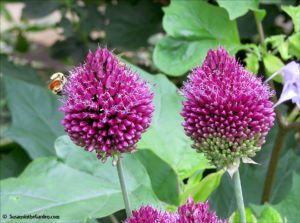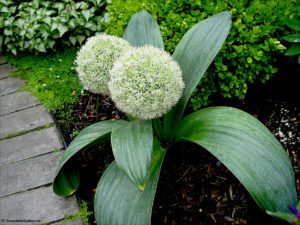Sept. 18 column: Specialty bulbs

I know next spring seems so far off but fall is the time for planting spring-blooming bulbs. But not just any bulbs, mind you. Why not plant some of the less common specialty bulbs? That’s exactly what I wrote about for today’s garden column. Here’s a link to it: Plant bulbs this fall for a colorful display next spring. (you can also read my column lower in this post)
If you’re wondering what types of bulbs are considered specialty bulbs, I’m primarily talking about snowdrops, Frittilaria, Alliums and unusual grape hyacinths. There are a lot of great sources for them, both in local, well-stocked garden centers and online. This is the time of year to order them. My biggest problem is not getting carried away and spending a ton of money after looking through the catalogs!
The time frame for planting spring-blooming bulbs is after your weather gets coolers but before the ground freezes. Bulb packages will tell you how deeply to plant them and the spacing as well. Most bulbs look more natural and are more eye-catching when you plant them in groupings of some sort, rather than in a straight line.
I recently put in my order for bulbs and can’t wait for the package to arrive. The great thing is that bulb purveyors do a good job of sending your package when the time is right, so I won’t have to worry about jumping the gun!
If you’re wondering about the identity of the bulbs in these photos, all three are Alliums. The top is ‘Globemaster’, the bulb directly above is ‘Drumstick’ and to the right is ‘Ivory Queen’. Aren’t they wonderful? And wouldn’t they look great in your garden?
I hope my column will pique your interest and perhaps encourage you to try some bulbs that you wouldn’t ordinarily think of planting. They’ll be a lovely surprise come spring!
Specialty Bulbs garden column:
by Susan Mulvihill
With the growing season rapidly coming to a close, you might not want to hear there’s one extra task to do. However, this one will add color to your garden when you’ll want it most. I’m talking about planting specialty bulbs this fall to brighten up your flower beds in the spring.
It’s probably safe to say every garden has at least a few tulips or daffodils. We all love them but there are so many other interesting bulbs that are often overlooked. All of the following should be planted after a killing frost and before the ground freezes.
One of the earliest bulbs to bloom in my garden is Glory of the Snow (Chionodoxa). With a height of 4 to 8 inches, they’re rather diminutive but they make up for it with their perky 6-petaled flowers in white (Alba), lavender-blue (Blue Giant) and pale pink (Pink Giant). The bulbs spread at a manageable rate, giving gardeners more bang for their buck. They’re hardy down to USDA zone 3.
Siberian squill (Scilla siberica) is a deer-resistant bulb that also slowly spreads. I love the intense blue flowers of Spring Beauty (zone 3, 4 inches) and hope to acquire some meadow squill (S. litardierei) after reading about their lavender to royal-blue blossoms. They’re hardy to zone 4 and grow up to 8 inches tall.
Most gardeners are familiar with petite snowdrops that have white-and-green nodding flower heads but I want to go bigger. Giant snowdrops (Galanthus elwesii) have larger flowers, grow up to 8 inches tall and are hardy to zone 3. An alternative is summer snowflake (Leucojum aestivum) with similar flowers but a height of 12 to 15 inches.
Grape hyacinths (Muscari) are fairly common in gardens so I’m looking for more unusual cultivars. The Scheepers catalog writes this about Ocean Magic (M. aucheri): “sparkling like a sun-dappled ocean, each stem has a cobalt-blue base that gradually blends into a wave-frothed white tip.” Sign me up for that one. The blossoms of White Magic start out pale green and mature to a pristine white. Both are hardy to zone 4 and grow 6 inches tall.
Other Muscari of note include Golden Fragrance (M. macrocarpum) with purple-topped, yellow flower spikes that are lightly-fragrant (5 inches) and feather hyacinths (M. cosmosum plumosum) with their violet-colored, ethereal flower plumes (10 inches).
Every year when I go on garden tours, I resolve to plant the alliums (flowering onions) I’ve seen. By the fall, I’ve usually forgotten all about it, but not this year. Alliums are tough, deer-resistant and bloom in May and June; most are hardy to zone 4.
The purple globes of Star of Persia (A. christophii) remind me of fireworks and grow 18 to 24 inches tall. I love the blue-green, strap-like leaves and white spheres of Ivory Queen (A. karataviense), which reaches 10 inches in height. And while drumstick allium bulbs (A. sphaerocephalon) aren’t necessarily uncommon, I always appreciate how terrific they look when planted in nice groupings within a bed. They grow 24 inches tall.
Globemaster (A. christophii x macleanii) bulbs are a bit pricey but they make a jaw-dropping impression in the garden with their 10-inch-diameter violet spheres and 24- to 36-inch-tall stems.
Looks like it’s time to put together my shopping list.
Susan Mulvihill is co-author, with Pat Munts, of “Northwest Gardener’s Handbook.” Contact her at Susan@susansinthegarden.com.
[INFO BOX]SOURCES
In addition to local garden centers, specialty bulbs can be found online at the following:
- Breck’s: brecks.com, (513) 354-1511
- Brent and Becky’s Bulbs: brentandbeckysbulbs.com, (877) 661-2852
- Dutch Gardens: dutchgardens.com, (800) 944-2250
- Dutch Grown, dutchgrown.com, (800) 277-0215
- John Scheepers: johnscheepers.com, (860) 567-0838


